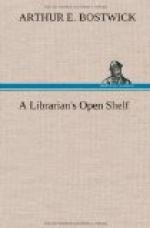This being the case, it is certainly interesting to find that, entirely without the aid or consent of those who have at heart the interests of the drama, a new dramatic form has grown up which caters to the utmost to the modern desire for realistic detail—far beyond the dreams of ordinary stage settings—and at the same time makes possible the quick transitions that are the glory of the Elizabethan drama. Here, of course, is where we make connection with the moving picture, whose fascinating realism and freedom from the taint of the footlights have perhaps been sufficiently insisted upon in what has been already said. In the moving picture, with the possibility of realistic backgrounds such as no skill, no money, no opportunity could build up on the ordinary stage—distant prospects, marvels of architecture, waving trees and moving animals—comes the ability of passing from one environment to another, on the other side of the globe perhaps, in the twinkling of an eye. The transitions of the Elizabethan stage sink into insignificance beside the possibilities of the moving-picture screen. Such an alternation as is now common in the film play, where two characters, talking to each other over the telephone, are seen in quick succession, would be impossible on the ordinary stage. The Elizabethan auditor, if his imagination were vivid and ready, might picture such a background of castle or palace or rocky coast as no photographer could produce; but even such imagination takes time to get under way, whereas the screen-picture gets to the brain through the retina instantly.
It is worth our while, I think, to consider whether this kind of scenery, rich in detail, but immaterial and therefore devoid of weight, could not be used in connection with the ordinary drama. There are obstacles, but they do not appear insuperable. The ordinary moving-picture, of course, is much smaller than the back drop of a large stage. Its enlargement is merely a matter of optical apparatus. Wings must be reduced in number and provided each with its own projection-machine, or replaced with drops similarly provided. Exits and entrances must be managed somewhat differently than with ordinary scenery.




